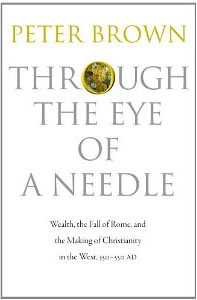Book Notes
 Peter Brown, Through the Eye of a Needle; Wealth, the Fall of Rome, and the Making of Christianity in the West, 350–550 AD (Princeton: Princeton University Press, 2012), 759pp.
Peter Brown, Through the Eye of a Needle; Wealth, the Fall of Rome, and the Making of Christianity in the West, 350–550 AD (Princeton: Princeton University Press, 2012), 759pp.
In perhaps the hardest of all his hard sayings, Jesus told the rich young ruler, "if you would be perfect, go, sell what you possess and give to the poor, and you will have treasure in heaven; and come, follow me." When the young man refused this invitation and "went away sad," Jesus concluded, "It is easier for a camel to go through the eye of a needle than for a rich man to enter the kingdom of God." Peter Brown, professor emeritus at Princeton University and the leading historian of late antiquity, has written a masterful study of how Christians in the Roman Empire grappled with those words. His book is characterized by lively prose, mastery of the primary sources and original languages, comprehensive use of changes in the study of antiquities (especially the "material culture" of archaeology), gorgeous plates, nearly 300 pages of bibliographic end material, and a number of important revisions to the standard historiography.
Brown is especially interested in the exact consequences of the conversion of Constantine. First, he rejects "the great myth of the primal poverty of the early Christians." Also, it's true that the church gained new privileges under Constantine, but other groups enjoyed similar and even better privileges. Nor did Constantine usher in a time of new wealth for the church. That did not happen for another generation, until the year 370 or so. Until then, he credits the down-market "mediocres" or "in-betweeners" with being the church's biggest supporters — the "middling people" between the super rich and the oppressed poor, artisans, small farmers, small town clerics, tradesmen, and minor officials. These people who "knew their place" were "the solid keel of the Christian congregations through the fifth century." Their giving represented not merely random expressions of compassion for the poor, but also pious acts to transfer wealth on earth to treasure in heaven. Around the year 350, argues Brown, Christianity was still "invisible within the walls of Rome."
The late fourth century marked a turning point, when significant money entered what until then had been a church of no significant wealth, populated by "mediocres," and devoid of social status. What followed was "an explosion of writing" on the subject of wealth by luminaries like Ambrose, Augustine, and Jerome. Only with the final fall of the Roman empire in the late fifth century did powerful bishops fill the void created by the collapse of the imperial aristocracy. There are no easy answers here to the hard saying of Jesus. Brown documents the many and various ways that the social imaginations of believers of this limited time and place grappled with the challenge, from radical renunciation by the super rich, the "anti-wealth" of the ascetics, care of the poor, the everyday generosity of ordinary believers, and, finally, the clerical stewardship of massive wealth as God's providential gift.


